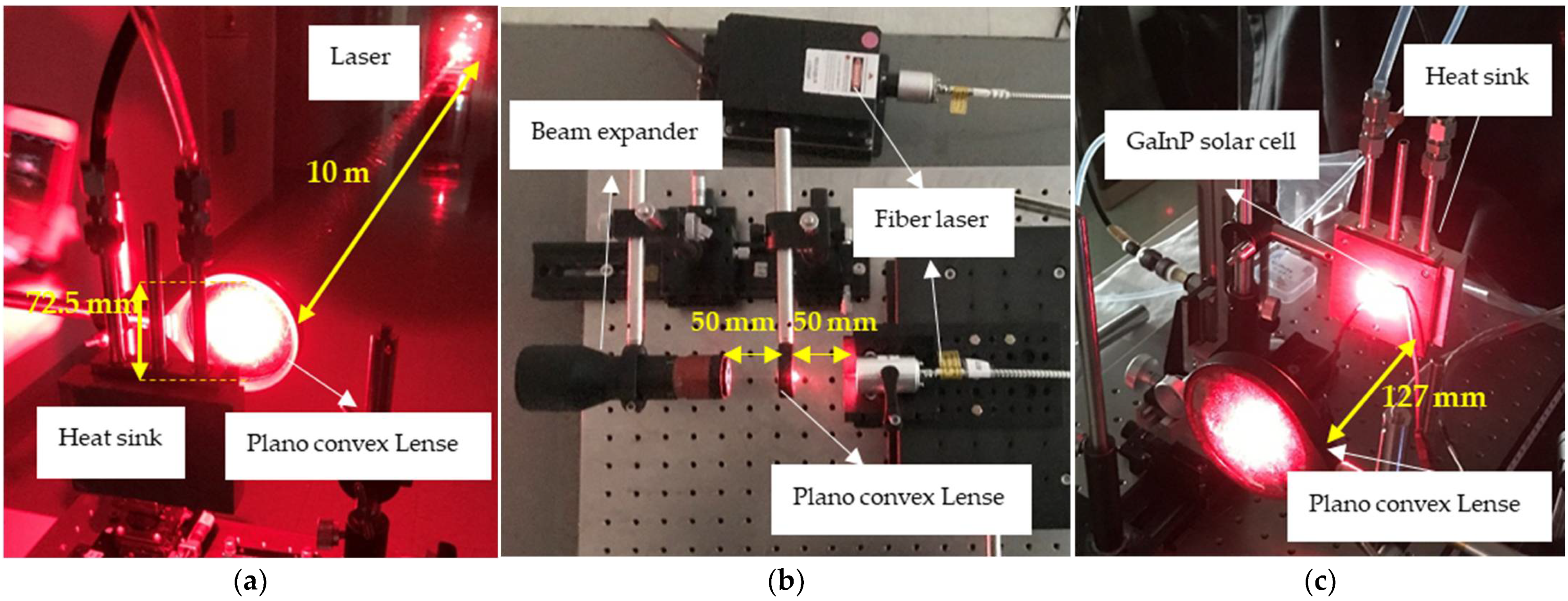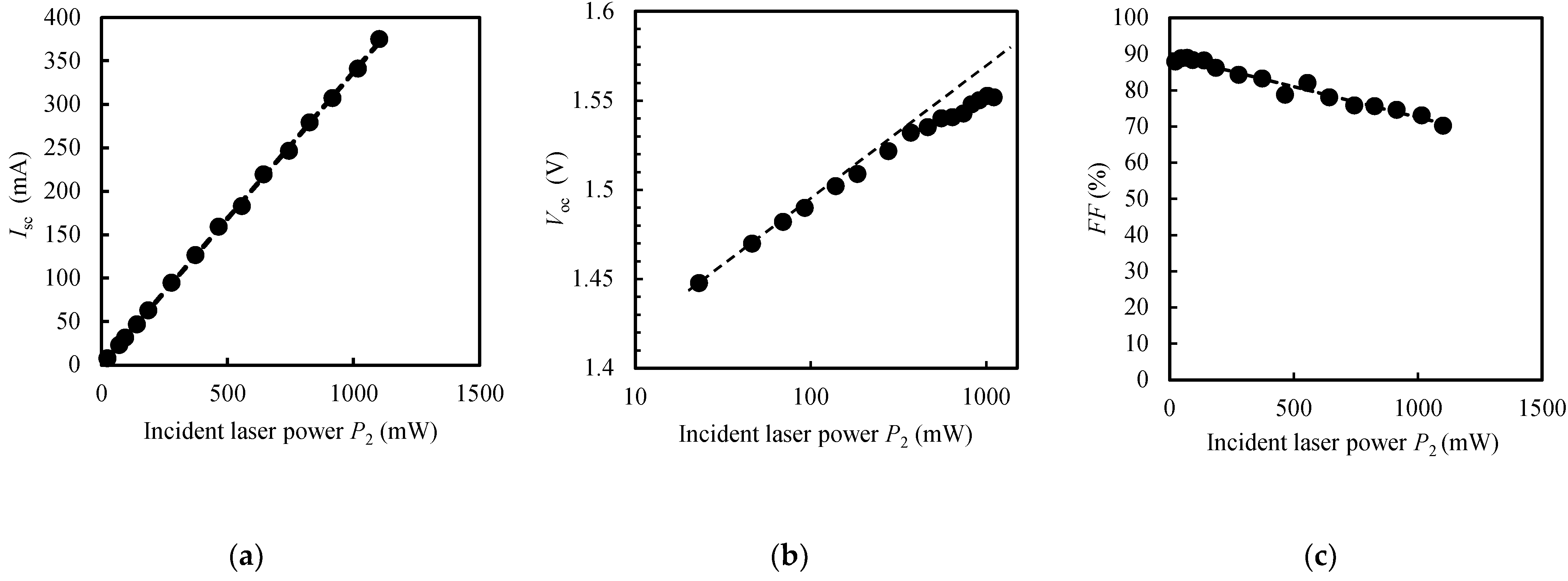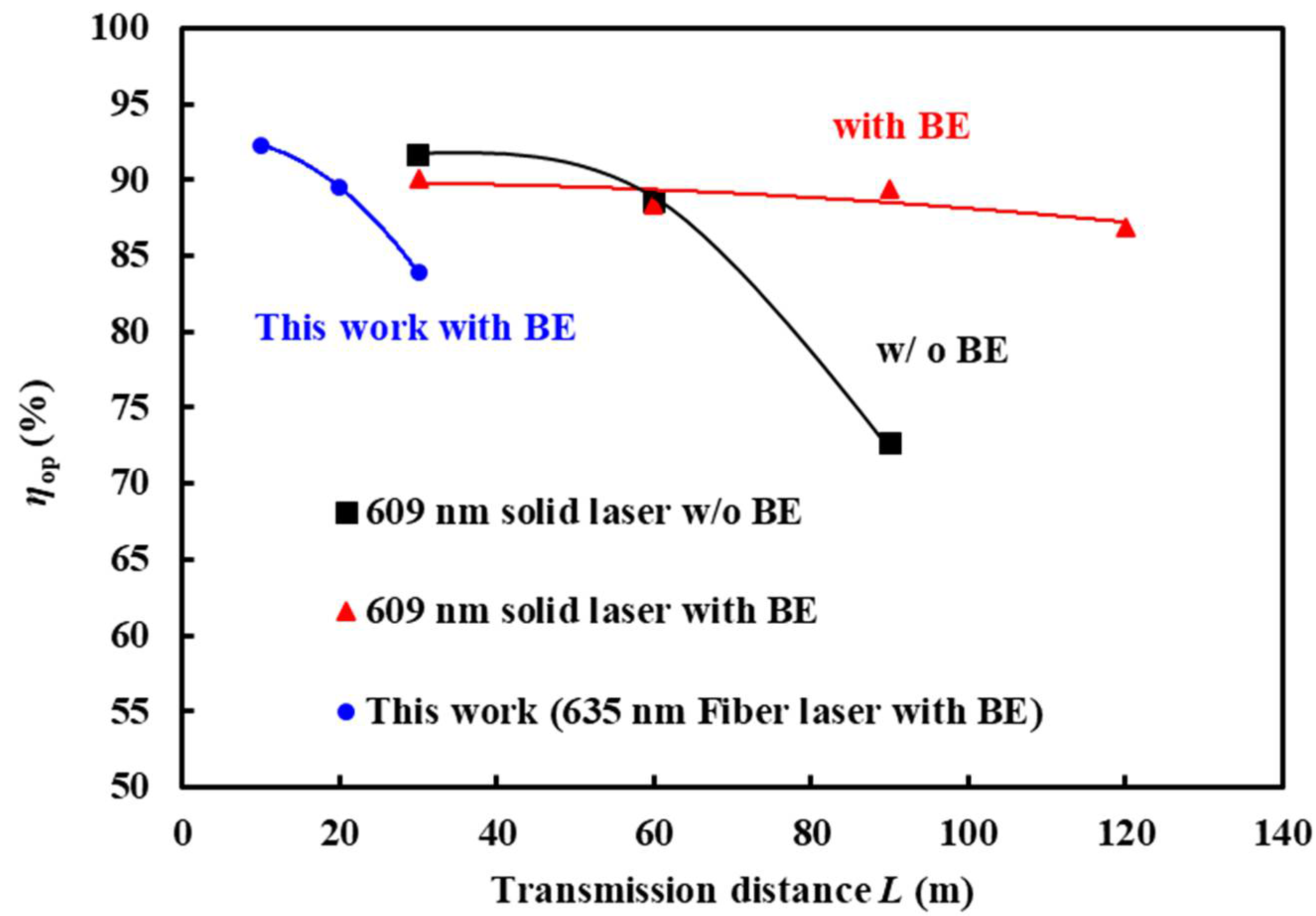Optical Wireless Power Transmission Using a GaInP Power Converter Cell under High-Power 635 nm Laser Irradiation of 53.5 W/cm2
Abstract
:1. Introduction
2. Materials and Methods
3. Results
4. Discussions
4.1. Photoelectric Conversion Efficiency of GaInP
4.2. Transmission Distance
4.3. High Energy Density Power Transmission
5. Conclusions
Author Contributions
Funding
Institutional Review Board Statement
Informed Consent Statement
Data Availability Statement
Conflicts of Interest
References
- Shoki, H. Issues and Initiatives for Practical Deployment of Wireless Power Transfer Technologies in Japan. Proc. IEEE 2013, 101, 1312–1320. [Google Scholar] [CrossRef]
- Tanaka, Y.; Hamase, H.; Kanai, K.; Hasaba, R.; Sato, H.; Koyanagi, Y.; Ikeda, T.; Tani, H.; Gokan, M.; Kajiwara, S.; et al. Simulation and Implementation of Distributed Microwave Wireless Power Transfer System. IEEE Trans. Microw. Theory Tech. 2022. [Google Scholar] [CrossRef]
- Goto, D.; Yoshida, H.; Suzuki, H.; Kisara, K.; Ohashi, K. The Overview of JAXA Laser Energy Transmission R&D Activities and the Orbital Experiments Concept on ISS-JEM. In Proceedings of the International Conference on Space Optical Systems and Applications (ICSOS), Kobe, Japan, 7–9 May 2014; p. S5-2. [Google Scholar]
- Landis, G.A. Laser Power Beaming for Lunar Polar Exploration. In Proceedings of the 2020 AIAA Propulsion & Energy Forum and Exposition, Online, 24–26 August 2020. paper AIAA-2020–3538. [Google Scholar]
- Zhou, Y.; Miyamoto, T. 200mW-class LED-based optical wireless power transmission for compact IoT. Jpn. J. Appl. Phys. 2019, 58, SJJC04. [Google Scholar] [CrossRef]
- Sumi, F.H.; Dutta, L.; Saker, F. Future with Wireless Power Transfer Technology. J. Electr. Electron. Syst. 2018, 7, 1000279. [Google Scholar] [CrossRef]
- Hayakawa, A.; Ike, Y.; Nagaoka, R.; Nagai, T.; Wani, F. Wavefront Fluctuation Influences in Optical Energy Transmission. Rev. Laser Eng. 2019, 47, 681–683. [Google Scholar] [CrossRef]
- Fafard, S.; Masson, D.; Werthen, J.-G.; Liu, J.; Wu, T.-C.; Hundsberger, C.; Schwarzfischer, M.; Steinle, G.; Gaertner, C.; Piemonte, C.; et al. Power and Spectral Range Characteristics for Optical Power Converters. Energies 2021, 14, 4395. [Google Scholar] [CrossRef]
- Raible, D.E. High Intensity Laser Power Beaming for Wireless Power Transmission. 2008, ETD Archive. 576. Available online: https://engagedscholarship.csuohio.edu/etdarchive/576 (accessed on 13 April 2022).
- Helmers, H.; Lopez, E.; Höhn, O.; Lackner, D.; Schön, J.; Schauerte, M.; Schachtner, M.; Dimroth, F.; Bett, A.W. 68.9% efficient GaAs-based photonic power conversion enabled by photon recycling and optical resonance. Phys. Status Solidi (RRL) Rapid Res. Lett. 2021, 15, 2100113. [Google Scholar] [CrossRef]
- Fakidi, J.; Videv, S.; Kucera, S.; Claussen, H.; Haas, H. Indoor Optical Wireless Power Transfer to Small Cells at Nighttime. J. Light. Technol. 2016, 34, 3236–3258. [Google Scholar] [CrossRef] [Green Version]
- Steinsiek, F.; Weber, K.H.; Foth, W.P.; Foth, H.J.; Schafer, C. Wireless power transmission experiment using an airship as relay system and a moveable rover as ground target for later planetary exploration missions. In Proceedings of the 8th ESA Workshop on Advanced Space Technologies for Robotics and Automation, Noordwijk, The Netherlands, 2–4 November 2004; pp. 1–10. [Google Scholar]
- Komuro, Y.; Honda, S.; Kurooka, K.; Warigaya, R.; Tanaka, F.; Uchida, S. A 43.0% efficient GaInP photonic power converter with a distributed Bragg reflector under high-power 638nm laser irradiation of 17Wcm−2. Appl. Phys. Express 2021, 14, 052002. [Google Scholar] [CrossRef]
- Yiu Leung, W.; Shibuya, T.; Hayashi, S.; Komazawa, Y.; Kurooka, K.; Kikuchi, T.; Koga, M.; Shibui, S.; Honda, T.; Uchida, S. Long-Distance Optical Wireless Power Transmission over 100 m using GaInP Solar Cell under 609 nm Laser Irradiation. In Proceedings of the 31st International Photovoltaic Science and Engineering Conference, PVSEC-31, Online, 13–15 December 2021; Paper 63. [Google Scholar]
- Tai, Y.; Miyamoto, T. Experimental Configuration and Characterization of Fly-eye Lens Based Underwater Optical Wireless Power Transmission. In Proceedings of the 4th Optical Wireless and Fiber Power Transmission Conference, 4th OWPT, Online, 18–20 April 2022; OWPT3-02. [Google Scholar]
- Hayashi, S.; Aoki, Y.; Komuro, Y.; Sudo, T.; Kato, T.; Yiu Leung, W.; Uchida, S. Laser wireless power transmission in seawater environment. In Proceedings of the 3rd Optical Wireless and Fiber Power Transmission Conference, 3rd OWPT, Online, 19–22 April 2021; OWPT-P-09. [Google Scholar]
- Riza, N.A.; Huang, Y. High speed optical scanner for multi-dimensional beam pointing and acquisition. In Proceedings of the 1999 IEEE LEOS Annual Meeting Conference Proceedings. LEOS'99. 12th Annual Meeting. IEEE Lasers and Electro-Optics Society 1999 Annual Meeting (Cat. No. 99CH37009), San Francisco, CA, USA, 8–11 November 1999; Volume 1, pp. 184–185. [Google Scholar]
- Riza, N.A.; Khan, S.A. Ultra-low loss laser communications technique using smart beamforming optics. Opt. Commun. 2006, 257, 225–246. [Google Scholar] [CrossRef]
- Marraccini, P.J.; Riza, N.A. Power smart in-door optical wireless link design. J. Eur. Opt. Soc. Rapid Publ. (EOS-JEOS) 2011, 6, 11054. [Google Scholar] [CrossRef] [Green Version]
- Marraccini, P.J.; Riza, N.A. Smart multiple-mode indoor optical wireless design and multimode light source smart energy-efficient links. SPIE Opt. Eng. 2013, 52, 055001. [Google Scholar] [CrossRef]
- Zhao, M.; Miyamoto, T. Optimization for Compact and High Output LED-Based Optical Wireless Power Transmission System. Photonics 2022, 9, 14. [Google Scholar] [CrossRef]
- Kurooka, K.; Honda, S.; Komuro, Y.; Warigaya, R.; Uchida, S. Effect of uniform laser irradiation on the efficiency of GaAs solar cells for optical wireless power transmission. Technical Digest. In Proceedings of the 3rd Optical Wireless and Fiber Power Transmission Conference, 3rd OWPT, Online, 19–22 April 2021; OWPT-P-06. [Google Scholar]
- Ikeda, M.; Kaneko, K. Selenium and zinc doping in Ga0.5In0.5P and (Al0.5Ga0.5)0.5In0.5P grown by metalorganic chemical vapor deposition. J. Appl. Phys. 1989, 66, 5285. [Google Scholar] [CrossRef]
- Wiley, J.D. Semiconductors and Semimetals; Willardson, R.K., Beer, A.C., Eds.; Elsevier: Amsterdam, The Netherlands, 1975; Volume 10. [Google Scholar]






| Ref. | Wavelength (nm) | Cell TYPE | Incident Energy Pin | Distance (m) | ηpv (%) | ηsystem (%) |
|---|---|---|---|---|---|---|
| [8] | 1550 | InGaAs | >0.5 W | - | 36 | - |
| [9] | 940 | Si | 0.0560 W/cm2 | 15 | 14.6 | <8.5 |
| [10] | 858 | GaAs | 11.4 W/cm2 | - | 68.9 | - |
| [11] | 660 | Si | 0.56 W | 5.2 | 13.3 | 3.2 |
| [12] | 532 | GaInP | 0.27 W/cm2 (4.3 W) | 80 | 40 | 35 |
| [13] | 638 | GaInP | 17 W/cm2 (0.3 W) | - | 43 | - |
Publisher’s Note: MDPI stays neutral with regard to jurisdictional claims in published maps and institutional affiliations. |
© 2022 by the authors. Licensee MDPI, Basel, Switzerland. This article is an open access article distributed under the terms and conditions of the Creative Commons Attribution (CC BY) license (https://creativecommons.org/licenses/by/4.0/).
Share and Cite
Wong, Y.L.; Shibui, S.; Koga, M.; Hayashi, S.; Uchida, S. Optical Wireless Power Transmission Using a GaInP Power Converter Cell under High-Power 635 nm Laser Irradiation of 53.5 W/cm2. Energies 2022, 15, 3690. https://doi.org/10.3390/en15103690
Wong YL, Shibui S, Koga M, Hayashi S, Uchida S. Optical Wireless Power Transmission Using a GaInP Power Converter Cell under High-Power 635 nm Laser Irradiation of 53.5 W/cm2. Energies. 2022; 15(10):3690. https://doi.org/10.3390/en15103690
Chicago/Turabian StyleWong, Yiu Leung, Shunsuke Shibui, Masahiro Koga, Shunki Hayashi, and Shiro Uchida. 2022. "Optical Wireless Power Transmission Using a GaInP Power Converter Cell under High-Power 635 nm Laser Irradiation of 53.5 W/cm2" Energies 15, no. 10: 3690. https://doi.org/10.3390/en15103690
APA StyleWong, Y. L., Shibui, S., Koga, M., Hayashi, S., & Uchida, S. (2022). Optical Wireless Power Transmission Using a GaInP Power Converter Cell under High-Power 635 nm Laser Irradiation of 53.5 W/cm2. Energies, 15(10), 3690. https://doi.org/10.3390/en15103690





